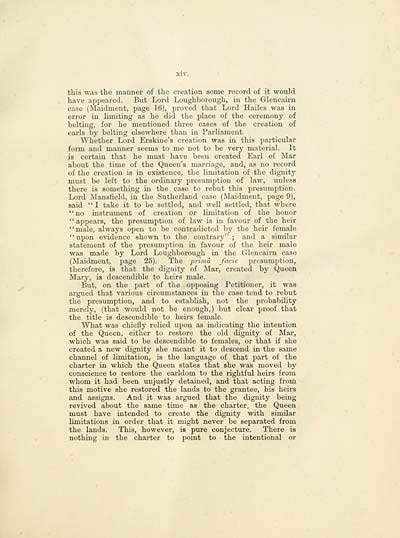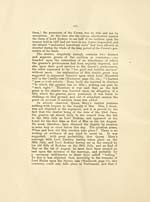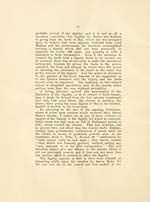Paper on the Mar peerage
(43) Page xiv
Download files
Complete book:
Individual page:
Thumbnail gallery: Grid view | List view

this was the manner of the creation some record of it would
have appeared. But Lord Loughborough, in the Glencairn
case (Maidinent, page 16), proved that Lord Hailes was in
error in limiting as he did the place of the ceremony of
belting, for he mentioned three cases of the creation of
earls by belting elsewhere than in Parliament.
Whether Lord Erskine's creation was in this particular
form and manner seems to me not to be very material. It
is certain that he must have been created Earl of Mar
about the time of the Queen's marriage, and, as no record
of the creation is in existence, the limitation of the dignity
must be left to the ordinary presumption of law, unless
there is something in the case to rebut this presumption.
Lord Mansfield, in the Sutherland case (Maidinent, page 9),
said " I take it to be settled, and well settled, that where
' ' no instrument of creation or limitation of the honor
" appears, the presumption of law is in favour of the heir
"male, always open to be contradicted by the heir female
"upon evidence shown to the contrary" ; and a similar
statement of the presumption in favour of the heir male
was made by Lord Loughborough in the Glencairn case
(Maidment, page 25). The prima facie presumption,
therefore, is that the dignity of Mar, created by Queen
Mary, is descendible to heirs male.
But, on the part of the opposing Petitioner, it was
argued that various circumstances in the case tend to rebut
the presumption, and to establish, not the probability
merely, (that would not be enough,) but clear proof that
the title is descendible to heirs female.
What was chiefly relied upon as indicating the intention
of the Queen, either to restore the old dignity of Mar,
which was said to be descendible to females, or that if she
created a new dignity she meant it to descend in the same
channel of limitation, is the language of that part of the
charter in which the Queen states that she was moved by
conscience to restore the earldom to the rightful heirs from
whom it had been unjustly detained, and that acting from
this motive she restored the lands to the grantee, his heirs
and assigns. And it was argued that the dignity being
revived about the same time as the charter, the Queen
must have intended to create the dignity with similar
limitations in order that it might never be separated from
the lands. This, however, is pure conjecture. There is
nothing in the charter to point to the intentional or
have appeared. But Lord Loughborough, in the Glencairn
case (Maidinent, page 16), proved that Lord Hailes was in
error in limiting as he did the place of the ceremony of
belting, for he mentioned three cases of the creation of
earls by belting elsewhere than in Parliament.
Whether Lord Erskine's creation was in this particular
form and manner seems to me not to be very material. It
is certain that he must have been created Earl of Mar
about the time of the Queen's marriage, and, as no record
of the creation is in existence, the limitation of the dignity
must be left to the ordinary presumption of law, unless
there is something in the case to rebut this presumption.
Lord Mansfield, in the Sutherland case (Maidinent, page 9),
said " I take it to be settled, and well settled, that where
' ' no instrument of creation or limitation of the honor
" appears, the presumption of law is in favour of the heir
"male, always open to be contradicted by the heir female
"upon evidence shown to the contrary" ; and a similar
statement of the presumption in favour of the heir male
was made by Lord Loughborough in the Glencairn case
(Maidment, page 25). The prima facie presumption,
therefore, is that the dignity of Mar, created by Queen
Mary, is descendible to heirs male.
But, on the part of the opposing Petitioner, it was
argued that various circumstances in the case tend to rebut
the presumption, and to establish, not the probability
merely, (that would not be enough,) but clear proof that
the title is descendible to heirs female.
What was chiefly relied upon as indicating the intention
of the Queen, either to restore the old dignity of Mar,
which was said to be descendible to females, or that if she
created a new dignity she meant it to descend in the same
channel of limitation, is the language of that part of the
charter in which the Queen states that she was moved by
conscience to restore the earldom to the rightful heirs from
whom it had been unjustly detained, and that acting from
this motive she restored the lands to the grantee, his heirs
and assigns. And it was argued that the dignity being
revived about the same time as the charter, the Queen
must have intended to create the dignity with similar
limitations in order that it might never be separated from
the lands. This, however, is pure conjecture. There is
nothing in the charter to point to the intentional or
Set display mode to:
![]() Universal Viewer |
Universal Viewer | ![]() Mirador |
Large image | Transcription
Mirador |
Large image | Transcription
Images and transcriptions on this page, including medium image downloads, may be used under the Creative Commons Attribution 4.0 International Licence unless otherwise stated. ![]()
| Histories of Scottish families > Paper on the Mar peerage > (43) Page xiv |
|---|
| Permanent URL | https://digital.nls.uk/94944326 |
|---|
| Description | A selection of almost 400 printed items relating to the history of Scottish families, mostly dating from the 19th and early 20th centuries. Includes memoirs, genealogies and clan histories, with a few produced by emigrant families. The earliest family history goes back to AD 916. |
|---|

